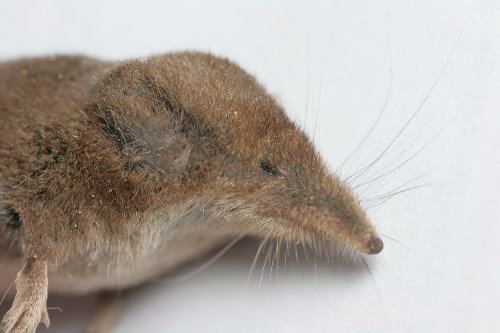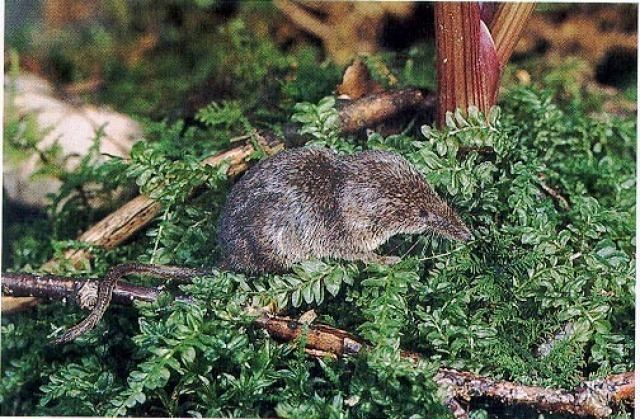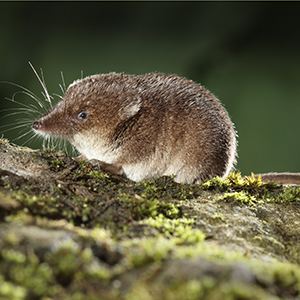Family Soricidae Trophic level Carnivorous Gestation period 18 days | Phylum Chordata Genus Sorex Mass 4.3 g (Adult) Length 5.7 cm (Adult) | |
 | ||
Conservation status Least Concern (Population stable) Similar Shrew, Sorex, Mammal, Northern short‑tailed shrew, American water shrew | ||
The cinereus shrew or masked shrew (Sorex cinereus) is a small shrew found in Alaska, Canada and the northern United States. This is the most widely distributed shrew in North America, where it is also known as the common shrew.
Contents

Description

It is grey-brown in colour with a light grey underside and a pointed snout. It has a long tail which is brown on top and pale underneath with a dark tip. Its body is about 9 cm in length including a 4 cm long tail. It weighs about 5 g. It has darker coloring than other shrews. Masked shrews can live up to two years, but averagely only survive eighteen months.

Yom-Tov et al. (2005) found that the masked shrew body size opposes Bergmann’s rule, decreasing with latitude and increasing with January temperatures in Alaska. Also, Yom-Tov et al. (2005) showed that body and tail length increased with rising temperatures during the second half of the twentieth century. This may be due to higher temperatures increasing the availability of the shrews’ diets.
Distribution

The masked shrew is the most widely distributed shrew (Merritt 1995). Its range covers most of northern North America extending south as far down to Maryland, along the Rocky Mountains in the west, and to the Appalachians in the east. This species was introduced into Newfoundland in the late 1950s. It can be found in many types of habitat like arid grasslands, moist areas, woodland and tundra. The masked shrew mostly lives in humid areas and with high levels of vegetation to hide in. Moisture determines the abundance of this shrew.
Predation and Parasitism
Predators include larger shrews, hawks, owls, shrikes, snakes, herons, and foxes, leopard frog, bluebird, brown trout, and weasels. Masked shrews are susceptible to many types of parasites, like fleas and tapeworms (Cowan 2007). Cowan et al. (2007) found that the high volume of food masked shrews consume causes them to be more susceptible to parasitism. Since males have larger ranges they have a higher exposure to parasites (Cowan 2007).
Diet and Prey
Masked shrews are opportunistic generalists. They eat insects, worms, snails, small rodents, salamanders, and seeds. Due to its high metabolism, the masked shrew can eat three times its weight a day (Whitaker 2004). The shrews have to eat almost constantly because they can only survive a few hours without food (Whitaker 2004). Their metabolism drops when they are at rest.
McCay et al. (1997) found a higher abundance of masked shrews in non-irrigated forests due to a higher availability of larval insects, which was the preferred food source of the masked shrew. Masked shrews chose Lepidoptera larva over other food sources (McCay 1997).
Behavior
This animal is active day and night year-round. Masked shrews can be nocturnal or diurnal depending on the weather. Doucet et al. (1974) showed that rain increases the nocturnal activity of the masked shrew, while cloud cover increases day and night activity. It digs tunnels but also uses tunnels created by other small mammals. It uses dry grass to make nests in these tunnels. It can make high frequency pulses and has lateral scent glands. The home range of the masked shrew depends on availability of food, but is averagely 0.55 hectare. It has a low tolerance for other shrews in its home range. Merritt et al. (1995) found that its mass declined by half from summer to winter and non-shivering heat production, energy conservation, and reduced body mass.
Reproduction
Masked shrews living at high latitudes are born in late spring and summer, reach adult size by the time they leave their nests and complete their life cycle within a year (Yom-Tov 2005). They are born during spring or summer, remain immature in winter, and breed the following spring (Merritt 1995). Masked shrews breed from May to September. Females have one litter of 6-7 young during the breeding season. The young are born hairless, clawless, and have translucent abdominal walls (Whitaker 2004). Body mass increases and peaks at twenty days, then decreases when the young leave the nest after about 27 days. Masked shrews have a high chance of mortality during their first two months of life and most die during the first year. Masked shrews become sexually mature at two months, but wait until their first spring to breed.
